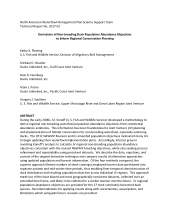
ABSTRACT
During the early 2000s, M. Koneff (U.S. Fish and Wildlife Service) developed a methodology to derive regional non-breeding waterfowl population abundance objectives from continental abundance estimates. This information has been foundational to Joint Venture (JV) planning and implementation of habitat conservation for non-breeding waterfowl, especially wintering ducks. The 2012 NAWMP Revision and its amended population objectives motivated many JVs to begin updating their waterfowl implementation plans. Accordingly, interest grew in revisiting Koneff’s analysis to calculate JV regional non-breeding population abundance objectives consistent with the revised NAWMP breeding objectives, while also seeking process refinement and repeatability using persistent datasets. We describe the data, equations, and caveats of the original derivation technique and compare results of alternative approaches using updated population and harvest information. Of the four methods compared, the superior approach (fewest number of short-comings) employed harvest data partitioned into separate autumn and mid-winter time periods, thus enabling finer temporal characterization of duck distribution and resulting population objective across individual JV regions. This approach
made use of the least biased and most geographically consistent datasets, collected over an extended time frame, and likely to be collected in a similar manner into the future. JV regional population abundance objectives are provided for the 17 most commonly harvested duck species. Recommendations for applying results along with uncertainties, assumptions, and limitations which will guide future revisions are provided.
